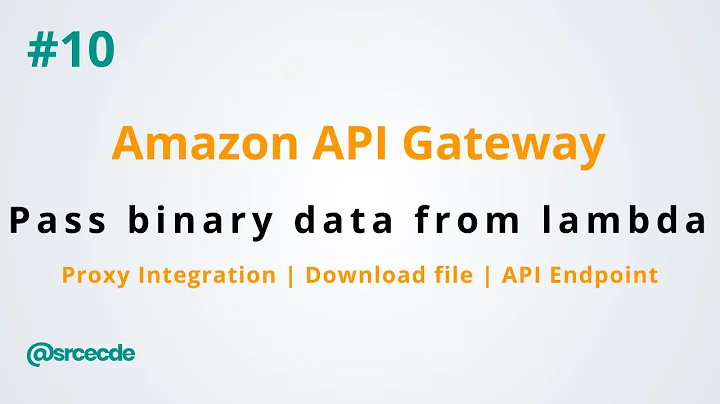AWS lambda api gateway error "Malformed Lambda proxy response"
Solution 1
Usually, when you see Malformed Lambda proxy response, it means your response from your Lambda function doesn't match the format API Gateway is expecting, like this
{
"isBase64Encoded": true|false,
"statusCode": httpStatusCode,
"headers": { "headerName": "headerValue", ... },
"body": "..."
}
If you are not using Lambda proxy integration, you can login to API Gateway console and uncheck the Lambda proxy integration checkbox.
Also, if you are seeing intermittent Malformed Lambda proxy response, it might mean the request to your Lambda function has been throttled by Lambda, and you need to request a concurrent execution limit increase on the Lambda function.
Solution 2
If lambda is used as a proxy then the response format should be
{
"isBase64Encoded": true|false,
"statusCode": httpStatusCode,
"headers": { "headerName": "headerValue", ... },
"body": "..."
}
Note : The body should be stringified
Solution 3
Yeah so I think this is because you're not actually returning a proper http response there which is why you're getting the error.
personally I use a set of functions like so:
module.exports = {
success: (result) => {
return {
statusCode: 200,
headers: {
"Access-Control-Allow-Origin" : "*", // Required for CORS support to work
"Access-Control-Allow-Credentials" : true // Required for cookies, authorization headers with HTTPS
},
body: JSON.stringify(result),
}
},
internalServerError: (msg) => {
return {
statusCode: 500,
headers: {
"Access-Control-Allow-Origin" : "*", // Required for CORS support to work
"Access-Control-Allow-Credentials" : true // Required for cookies, authorization headers with HTTPS
},
body: JSON.stringify({
statusCode: 500,
error: 'Internal Server Error',
internalError: JSON.stringify(msg),
}),
}
}
} // add more responses here.
Then you simply do:
var responder = require('responder')
// some code
callback(null, responder.success({ message: 'hello world'}))
Solution 4
For Python3:
import json
def lambda_handler(event, context):
return {
'statusCode': 200,
'headers': {
'Content-Type': 'application/json',
'Access-Control-Allow-Origin': '*'
},
'body': json.dumps({
'success': True
}),
"isBase64Encoded": False
}
Note the body isn't required to be set, it can just be empty:
'body': ''
Solution 5
I had this issue, which originated from an invalid handler code which looks completely fine:
exports.handler = (event, context) => {
return {
isBase64Encoded: false,
body: JSON.stringify({ foo: "bar" }),
headers: {
'Access-Control-Allow-Origin': '*',
},
statusCode: 200,
};
}
I got the hint from examining the somewhat confusing API Gateway response logs:
> Endpoint response body before transformations: null
The way to fix it would be to either
- Add the
asynckeyword (async function implicitly returns a Promise):
exports.handler = async (event, context) => {
return {
isBase64Encoded: false,
body: JSON.stringify({ foo: "bar" }),
headers: {
'Access-Control-Allow-Origin': '*',
},
statusCode: 200,
};
}
- Return a Promise:
exports.handler = (event, context) => {
return new Promise((resolve) => resolve({
isBase64Encoded: false,
body: JSON.stringify({ foo: "bar" }),
headers: {
'Access-Control-Allow-Origin': '*',
},
statusCode: 200,
}));
}
- Use the callback:
exports.handler = (event, context, callback) => {
callback({
isBase64Encoded: false,
body: JSON.stringify({ foo: "bar" }),
headers: {
'Access-Control-Allow-Origin': '*',
},
statusCode: 200,
});
}
My handler was previously declared async without ever using await, so I removed the async keyword to reduce complexity of the code, without realizing that Lambda expects either using async/await/Promise or callback return method.
Related videos on Youtube
Comments
-
jjbskir almost 2 years
I am trying to set up a hello world example with AWS lambda and serving it through api gateway. I clicked the "Create a Lambda Function", which set up the api gatway and selected the Blank Function option. I added the lambda function found on AWS gateway getting started guide:
exports.handler = function(event, context, callback) { callback(null, {"Hello":"World"}); // SUCCESS with message };The issue is that when I make a GET request to it, it's returning back a 502 response
{ "message": "Internal server error" }. And the logs say "Execution failed due to configuration error: Malformed Lambda proxy response". -
 Neo over 6 yearsIf "response" is the name of your object, using JSON.stringify(response) does not work. Leaving it like this worked for me.
Neo over 6 yearsIf "response" is the name of your object, using JSON.stringify(response) does not work. Leaving it like this worked for me.callback(null,response); -
 selftaught91 over 6 years@Neo You don't need to stringify the response object. You need to stringify the data inside the body key of response object
selftaught91 over 6 years@Neo You don't need to stringify the response object. You need to stringify the data inside the body key of response object -
andy mccullough over 6 yearsOut of curiosity - why does the body need to be stringified? This was a my issue on something i've been working on, and its left me confused - thanks
-
Palisand over 6 years
-
craigmichaelmartin over 6 yearsHere is an AWS support article on it: aws.amazon.com/premiumsupport/knowledge-center/…
-
Trenton about 6 yearsOf these, only
statusCodeis required for a call from API Gateway to succeed. -
 Kimutai almost 5 yearsEnsuring the body is stringified worked for me. Thanks a lot +1
Kimutai almost 5 yearsEnsuring the body is stringified worked for me. Thanks a lot +1 -
 Santhosh Nagulanchi almost 5 yearsNow, if we use Access-Control-Allow-Credentials value as true,we cant keep 'Access-Control-Allow-Origin' value as '*'
Santhosh Nagulanchi almost 5 yearsNow, if we use Access-Control-Allow-Credentials value as true,we cant keep 'Access-Control-Allow-Origin' value as '*' -
 Santhosh Nagulanchi almost 5 yearsI observed it supports only one Origin: headers: { "Access-Control-Allow-Origin" : "<<Single Domain>>", "Access-Control-Allow-Credentials" : true // Required for cookies, authorization headers with HTTPS },
Santhosh Nagulanchi almost 5 yearsI observed it supports only one Origin: headers: { "Access-Control-Allow-Origin" : "<<Single Domain>>", "Access-Control-Allow-Credentials" : true // Required for cookies, authorization headers with HTTPS }, -
Misha about 4 yearsOMG, thank you so much, you just saved me after hours of trying to figure out how to freakin get a header in the response. I tried plain JSON, didn't work. I tried key value pairs, didn't work. Dictionary was the way to go! THANK YOU!
-
Waleed93 almost 4 yearsThis answer was really helpful. Thanks!
-
 mgarciaisaia almost 4 years
mgarciaisaia almost 4 yearsThe body should be stringifiedOMG thanks for that -
 nog642 almost 3 yearsWhat if we're using WebSockets, not HTTP?
nog642 almost 3 yearsWhat if we're using WebSockets, not HTTP? -
Vimanyu almost 3 yearsI did the exact same thing - removed
asyncas I removed theawaitand started hitting the exact same issue! Your post really helped. Thanks!






